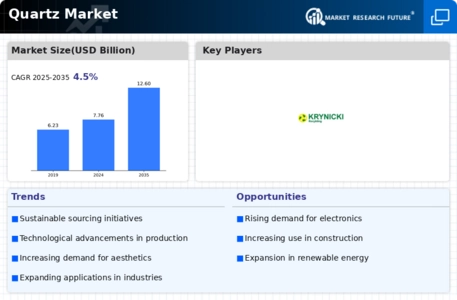Market Trends
Key Emerging Trends in the Quartz Market
The Quartz market is experiencing notable growth and evolving trends driven by its versatile applications in various industries, technological advancements, and shifting consumer preferences. Quartz, a naturally occurring mineral composed of silicon and oxygen atoms in a continuous framework of SiO4 silicon-oxygen tetrahedra, finds extensive use in applications such as construction, electronics, optics, and jewelry. One prominent trend in the Quartz market is the increasing demand for engineered quartz surfaces in the construction and remodeling sectors. Engineered quartz, also known as quartz countertops, is a durable and low-maintenance material made by combining crushed natural quartz with resin binders and pigments. With its aesthetic appeal, durability, and resistance to stains, scratches, and heat, engineered quartz has become a popular choice for kitchen and bathroom countertops, flooring, and wall cladding, driving the growth of the Quartz market.
Moreover, technological advancements in quartz processing and manufacturing techniques are driving innovation in the Quartz market. Manufacturers are investing in advanced machinery and production processes to improve the quality, consistency, and cost-effectiveness of quartz products. High-speed cutting and polishing equipment, as well as automated manufacturing lines, enable the efficient production of quartz slabs, tiles, and finished products with precise dimensions and surface finishes. Additionally, advancements in coloration and patterning technologies allow for the creation of a wide range of quartz designs and finishes, catering to diverse consumer preferences and design trends in the construction and interior design industries.
Another key trend in the Quartz market is the growing demand for quartz-based electronic components and devices. Quartz crystals, known for their piezoelectric properties and exceptional stability, are widely used in electronic applications such as oscillators, filters, sensors, and timing devices. With the proliferation of consumer electronics, telecommunications equipment, automotive electronics, and IoT devices, there is a rising demand for high-quality quartz crystals and oscillators that offer precise frequency control, low phase noise, and reliable performance in various operating environments. As industries continue to embrace digitalization and connectivity, the demand for quartz-based electronic components is expected to continue growing, driving the expansion of the Quartz market.
Furthermore, the Quartz market is influenced by broader economic factors such as urbanization, infrastructure development, and consumer spending. As economies grow and urban populations expand, there is a greater demand for residential, commercial, and infrastructure projects that require quartz-based materials such as countertops, flooring, wall cladding, and decorative elements. Moreover, rising disposable incomes and changing lifestyles drive consumer preferences for high-quality and aesthetically pleasing interior finishes, fueling demand for premium quartz products in the residential and commercial construction sectors.
The COVID-19 pandemic has impacted the Quartz market, causing disruptions in supply chains, project timelines, and consumer demand for construction and remodeling projects. However, the pandemic has also highlighted the importance of hygienic and easy-to-clean surfaces in residential and commercial spaces, driving greater interest in quartz countertops and surfaces that offer antimicrobial properties and easy maintenance. As economies recover and construction activity resumes, the demand for quartz-based materials is expected to rebound, driven by pent-up demand, renovation projects, and investments in infrastructure and real estate development.


 Source: Secondary Research, Primary Research, Market Research Future Database and Analyst Review
Source: Secondary Research, Primary Research, Market Research Future Database and Analyst Review

Leave a Comment